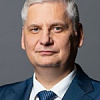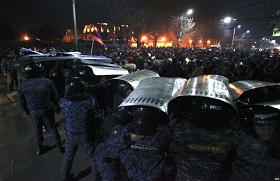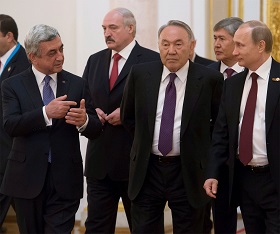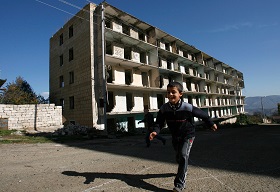Russia – Learning from Armenia
Mass protests, Yerevan, June 2015
(no votes) |
(0 votes) |
Ph.D in History, Leading Research Fellow at MGIMO University, Editor-in-Chief of International Analytics Magazine, RIAC Expert
The mass protests that swept Yerevan and other Armenian cities in June 2015 put Armenia at the focus of attention of politicians and experts. Protests flared up again on 1 September. While right now there are few signs of mass rallies taking place, the internal political situation in #Armenia, which sees itself as an ally of #Russia, is extremely important for Moscow’s foreign policy position itself in Transcaucasia.
The mass protests that swept Yerevan and other Armenian cities in June 2015 put Armenia at the focus of attention of politicians and experts. Ostensibly, the protests were triggered by the June 2015 decision of the Public Services Regulatory Commission (PSRC) to raise electricity tariffs [1].
Protests subsided after the Republic’s authorities promised to carry out an audit of Electric Networks of Armenia (ENA) and subsidize tariffs (100 per cent for households and partly for businesses). However, protests flared up again on 1 September [2]. While right now there are few signs of mass rallies taking place, the internal political situation in Armenia, which sees itself as an ally of Russia, is extremely important for Moscow’s foreign policy position itself in Transcaucasia.
Armenia’s Strategic Significance
First, Armenia is the only Transcaucasian country that is a member of the Collective Security Treaty Organization (CSTO). It has a Russian military base, and Russian border guards secure the republic’s outer boundaries alongside their Armenian colleagues. Second, since January 2, 2015 Yerevan has been an official member of the Eurasian Economic Union (EEU) [3]. Third, Moscow plays a very important role in the process of Nagorno-Karabakh settlement. Western diplomats and experts more often criticize Russia for “freezing” rather than seeking to solve this long-festering conflict [4]. We should bear in mind, however, that however passive Russia may be, neither Azerbaijan nor Armenia, which are directly involved in the ethno-political confrontation, have demonstrated any inclination to make compromises or concessions. Given this approach, “freezing” the conflict is not the worst of options, although ultimately it cannot bring about peace [5].
While remittances from the United States registered a slight increase, transfers from Russia dropped by about 56 per cent, which is attributed to economic problems within Russia and the impact of Western sanctions as a result of events in Ukraine.
Fourth, speaking of Russia–Armenia relations, the Armenian diaspora factor should not be ignored. There are currently slightly less than 1.2 million Armenians living in Russia (according to official census data) [6]. Experts give a larger figure [7]. This is the largest Armenian community outside of Armenia. Although Russian Armenians are citizens of at least three states (Russia, Armenia and Georgia, if one includes Armenians from the Samtskhe-Javakheti district) with different levels of command of their native tongue, integration into Russian society and material position, they are linked by many threads to what is happening in Yerevan, Gyumri and the unrecognized Nagorno-Karabakh [8].
And last but not least, there is the economy. Russia accounts for about half of all foreign investments in Armenia [9]. Russian companies own many strategic facilities in Armenia. The South Caucasus Railway is a subsidiary of Russian Railways. Russia’s Gazprom is the sole shareholder in Gazprom Armenia and Electric Networks of Armenia (the main protagonist in the events in the summer of 2015) is a subsidiary of Inter RAO UES [10].
Factors Adding Fuel to the Protests
Several factors exacerbate the protest situation in Armenia.
The tariff hike announced in June 2015 was the third in the last few years. In 2013, electricity rates increased by about a third [11]. And ENA offered no guarantees that there would not be others in the coming years. In 2016, the Armenian Nuclear Power Plant (which accounts for 45 per cent of all the country’s power generation) will be closed for repairs, which could provide another excuse for raising tariffs [12].
Although the organizers of mass protests in Yerevan and other cities in Armenia were at pains to deny that the actions pursued political goals and had an anti-Russian element, the Russia factor was present in one form or another from the very first day.
To cap it all off, the general socioeconomic situation remains lamentable. The economy grew by about 3.5 per cent in 2014, but that is well short of the planned target (5.2 per cent). If growth is to result in positive social dynamics, it should top the 6 per cent mark. Most of the growth occurred in the services and trade sectors and not in production [13].
Another worrisome challenge for the Armenian economy was the fall of the national currency – in late November 2014, the dram hit an eight-year low, dropping by 16.6 percentage points [14]. Another leap occurred in December. Currency fluctuations sent consumer prices soaring, adding to the many other woes besetting the Armenian people.
A large part of Armenia’s population lives on remittances from abroad. Remittances for private individuals dropped sharply in January 2015 ($72.1 million versus $122.5 million in January 2014). While remittances from the United States registered a slight increase, transfers from Russia dropped by about 56 per cent, which is attributed to economic problems within Russia and the impact of Western sanctions as a result of events in Ukraine. The drop in transfers, coupled with the devaluation of the dram, further pushes up consumer prices [15]. Another problem for the Armenian economy is falling exports and the trade deficit. Exports dropped by 22 per cent in January 2015 after Armenia joined the Eurasian Economic Union due to the change of customs rules, which have not yet been assimilated by the country’s business community, and the fall of the rouble against the dollar and euro. No appreciable progress has been registered in attracting investments into the country’s economy. Indeed, in 2009–2013 the influx of foreign investments into Armenia dropped by 42/2 per cent [16].
The Russia’s role perceived in Armenia
Although the organizers of mass protests in Yerevan and other cities in Armenia were at pains to deny that the actions pursued political goals and had an anti-Russian element, the Russia factor was present in one form or another from the very first day [17].
Electric Networks of Armenia a 100 per cent subsidiary of Russia’s Inter RAO UES (which in the popular mind makes Russia indirectly responsible for the social costs). The company has run up a debt of $250 million and has repeatedly been accused (even by the Ministry of Energy and Natural Resources of the Republic of Armenia) of embezzlement, mismanagement, buying expensive cars for its executives and overstaffing [18]. ENA reported annual losses of 16 per cent (the allowable norm is 12 per cent), with the loss of one per cent amounting to 2.5 billion drams (about 300 million roubles) [19]. The company was also criticized for the deal to purchase power from the Russian Armroscogeneration (at an average price of 60 drams per Kw/h, the highest in Armenia) [20]. The actions of ENA’s Director General Yevgeny Bibin added fuel to the fire [21]. Discontent with the company’s activities came to be associated with Russian big business in general [22]. The hype in the media was compounded by a number of other problems. Yerevan is very sceptical (to put it mildly) of the military-technical cooperation between Russia and Azerbaijan (which Moscow needs in order to maintain the status quo in the Caucasus and prevent Baku from being drawn into the Western orbit, as happened with Georgia) [23]. The “case of Valery Permyakov” (January 2015) seriously aggravated bilateral relations [24]. Like Russia–Azerbaijan cooperation it did not cause Yerevan to revise its foreign policy priorities, but rather created a negative emotional and psychological background.
At present, the positions of the critics of Russian policy in Armenia are not strong enough .
At present, the positions of the critics of Russian policy in Armenia are not strong enough [25]. However, they exploit such themes as Armenia’s “total dependence” on the Russian military and government authorities, “dragging” the country into the Eurasian Economic Union (EEU), “Russian support for Armenian authoritarianism”, Moscow’s reluctance to settle the Nagorno-Karabakh conflict, the need to put an end to isolation, which is allegedly good for Russia, and so on. The United States in the most active of the external players in Armenia. Thus, the U.S. Agency for International Development (USAID), the key vehicle of American “soft power” in the world, had an official budget of $23 million in 2014. In 2015, it was increased to $27 million [26].
However, we cannot rule out politicization of the mass protests (not necessarily over the tariffs issue) under certain circumstances, especially now that the authorities have started to promote the idea of constitutional reforms (the president spoke about it in September 2013; a concept of reform was unveiled in October 2014, which was approved by Serzh Sargsyan in March 2015). The reform would redistribute powers between the main governing bodies in favour of the parliament and government. If the project succeeds, the country’s president will be elected not by direct vote, like today, but by the National Assembly for a term of seven years. It would put real power (as opposed to protocol functions and “guarantees”) in the hands of the head of government or the parliament speaker. The current constitution (Article 50) forbids any person from holding the post of head of state for more than two successive terms. In accordance with the spirit and letter of the Constitution, Sargsyan will have to quit the post as President of the Republic of Armenia in 2018.
If the reforms are timed for the 2017–2018 electoral cycle (parliamentary campaign followed by a presidential campaign) and the ruling party (the Republicans) wins the parliamentary elections, Sargsyan has a real chance of “staying despite having gone”, for example, by becoming prime minister or parliament speaker or head of the ruling Republican Party instead of president [27].
For Russia, destabilization in Armenia is fraught with upsetting the status quo in Nagorno-Karabakh, and attempts to minimize the Russian influence in Transcaucasia as a whole.
Political Lessons for Armenia, Russia and Armenia–Russia Cooperation (recommendations)
In the current situation, it is imperative for Russian and Armenian politicians to draw lessons from the current social protests.
Whatever course the protest movement in Armenia chooses, social discontent remains high. Discontent with official policy may push individuals who have neither the background nor the competence needed to run the country into positions of prominence.
На сегодня позиции критиков политики России в республике недостаточно сильны.
Such a possibility increases because the ranks of disgruntled youth have been swelling since the latest wave of protests. Poorly organized and lacking political leaders, such a movement would be easy to manipulate. Especially because in 2013–2015 the Armenian opposition failed to unite and work out a credible alternative policy for the country’s development and concentrated too much on staging rallies. Besides, the authorities took steps to sideline potential rivals. Thus, in February 2015, a public scandal broke out involving former partners in the governing coalition (President Serzh Sargsyan and Gagik Tsarukyan) as a result of which the latter resigned as leader of the Prosperous Armenia Party and ceased to be regarded as a serious political player. Pushing him to the sidelines can be seen as a blow at the Second President of the Republic of Armenia Robert Kocharyan, who was considered Tsarukyan’s sponsor.
However, these moves sharpen the demand for new faces that are not connected with the current authorities. The problem of tariffs (even if it is settled amicably between the authorities and society) may be replaced by the issue of high consumer prices, the problem of diminished transfers from Russia and lack of transparency in managerial decision-making. Considering the close links of the current authorities with Russia, discontent would inevitably be transferred to Moscow.
In this situation, Yerevan should seek closer integration with civil society, which could become more than simply an additional risk, but a positive factor (providing effective feedback from society; a reservoir for power rotation that improves governance; and an instrument to defuse social tensions).
For Russia, destabilization in Armenia is fraught with upsetting the status quo in Nagorno-Karabakh, and attempts to minimize the Russian influence in Transcaucasia as a whole. Therefore, Moscow too should draw lessons from the current protests. Russia should expand cooperation with Armenia inside the country. At present, it is confined to the executive branch. It is exceedingly important to build up contacts between Russian and Armenian lawmakers, as well as influential centres of the Armenian diaspora in the West and East (these instruments can be used to adjust the attitude of these countries to Russian foreign policy).
Another issue is organizing interaction with the opposition. To this end it, is necessary to overcome the prejudice that the critics of today’s authorities are automatically anti-Russian. For example, the Prosperous Armenia Party (closely associated with the Second President of the Republic of Armenia Robert Kocharyan, and until recently part of the ruling coalition) is rightly seen as one of the more “Russophile” forces and many leaders of Armenian National Congress, headed by Levon Ter-Petrosyan, take a sceptical view of the benefits that might accrue form integration into Europe [28]. Even the members of the Heritage party, which is thought to be the most pro-Western, consider Russia’s role to be positive on many counts (especially regarding the Nagorno-Karabakh conflict). Thus, Russia needs, first, to overcome the situation when the sitting authorities abuse friendship with Moscow, seeking to strengthen their position by claiming to be just about the only reliable ally. Second, it should create a situation where a change of power would not have catastrophic consequences for Russia’s presence in Armenia. Diversifying contacts with the Armenian political community may be instrumental in solving both these tasks.
России необходимо расширить пространство взаимодействия внутри Армении. На сегодня оно, как правило, ограничивается исполнительной властью.
In addition to fostering links with politicians, Russia should develop contacts with the civil society (not only rights activists and leaders of social protests, but with young scientists, writers, teachers, journalists and businessmen). IT is one of the fastest growing industries in Armenia. And it is here that the United States’ presence can be felt, while Russia’s influence is insufficient [29].
Russia’s “soft power” harks back almost exclusively to the past (the shared memory of the Second World War). Although that theme should be pursued further, more attention should be paid to the trends that meet the demands of today (technologies, education programmes, Russian-sponsored careers in Russia and Armenia).
The Russian diplomatic establishment should do more to inform the public of the status of the Nagorno-Karabakh issue. The “freezing” of the conflict has come to be seen by many as a given. Meanwhile, the situation in the conflict zone is very dangerous. Clashes and ceasefire violations are becoming more frequent [30]. On November 12, 2014, the armed forces of Azerbaijan shot down an Armenian Mi-24 military helicopter (killing three crew members). This was the first incident of an aircraft being destroyed in the conflict zone since May 1994 [31]. In this situation, Russia’s role as the guarantor of the status quo is highly important. Yet very little is being done to bring this point home to the public, the assumption being that “everybody understands it anyway”. This state of affairs should be in short order. And Russia’s services must be presented more forcefully in opposition to the West’s rhetoric about “Moscow’s reluctance to secure peace”.
Adjustments in the economic sphere are also important. Tariffs and other current economic issues depend on many factors. However, Russian business giants should exercise more effective control over their subsidiary companies in Armenia. This would prevent Armenian social problems from being identified with the actions of Russia. Otherwise, the protests over utilities may be politicized in a way that is unfavourable for Russia.
All the measures proposed above would ensure a multi-factor and many-sided Russian presence in Armenia, one that is not confined to military political aspects. Coupled with Moscow’s positive role in maintaining the status quo around Nagorno-Karabakh and guarantees of national security, this would block the plans of Russia’s rivals who seek to weaken the Russia–Armenia strategic alliance and squeeze Russia out of the Southern Caucasus. This would, in turn, help Armenian politicians improve their domestic policies at a time of internal crisis and unresolved conflict.
1. http://www.kavkaz-uzel.ru/articles/264491/ (in Russian).
2. http://www.kavkaz-uzel.ru/articles/268146/ (in Russian).
3. http://www.rg.ru/2015/01/02/armenia-site.html (in Russian).
4. Hill F., Kirişci K. and Moffatt A. Retracing the Caucasian Circle: Considerations and constraints for U.S., EU, and Turkish engagement in the South Caucasus // http://www.brookings.edu/research/reports/2015/07/south-caucasus-engagement; Boonstra J. The South Caucasus concert: Each playing its own tune // http://www.cascade-caucasus.eu/754
5. http://m.forbes.ru/article.php?id=277889 (in Russian).
6. http://www.gks.ru/free_doc/new_site/perepis2010/croc/Documents/Vol4/pub-04-01.pdf (in Russian).
7. http://ria.ru/society/20021216/282886.html
8. Markedonov S. Russia’s Internal South Caucasus: The Role and Importance of Caucasus Societies for Russia // Caucasus Analytical Digest. 2009. No. 4.
9. http://www.regnum.ru/news/polit/1624407.html (in Russian); http://www.kremlin.ru/events/president/news/16176 (in Russian).
10. http://www.minchenko.ru/analitika/analitika_56.html (in Russian).
11. https://slon.ru/posts/53208 (in Russian).
12. http://arminfo.info/index.cfm?objectid=84612520-BCE1-11E4-88910EB7C0D21663 (in Russian).
13. http://www.minchenko.ru/analitika/analitika_56.html (in Russian).
14. http://kavpolit.com/articles/itogi_uhodjaschego_goda_dlja_armenii-12494/ (in Russian).
15. http://www.ritmeurasia.org/news--2015-01-18--armenija-pervye-dve-nedeli-v-eaes-16307 (in Russian).
16. http://newsinmir.com/biznes/94867-armeniya-ekonomicheskie-itogi-i-pessimisticheskie-ozhidaniya.html (in Russian).
17. On several occasions, protesters in Yerevan carried European Union flags. Although one of the protest leaders described the initiative thus: “Several people brought European Union flags. We immediately told them that they had no place here.” On July 2, 2015, when an EU flag was displayed by the prominent Armenian dissident and outspoken critic of Russian policy Paruir Airikyan, the participants called it a provocation and made him withdraw the symbol of European integration, saying it was inappropriate. As a result, he left to the shouts “Go away!” Airikyan later declared that the protesters “were not ready for freedom”. For more on the incident, see: http://www.mk.ru/politics/2015/06/24/koordinator-mitingov-v-erevane-rasskazal-kak-protest-ustroen-iznutri.html;
http://www.mk.ru/politics/2015/07/02/protestuyushhie-v-erevane-prognali-politika-s-flagami-es.html (both in Russian).18. https://eadaily.com/news/2015/06/09/elektrichestvo-v-armenii-podorozhaet-na-165 (in Russian).
19. http://rus.azatutyun.am/content/article/27014348.html (in Russian).
20. https://slon.ru/posts/53208 (in Russian).
21. Read more at: http://www.kavkaz-uzel.ru/articles/264107/ (in Russian).
22. http://ru.aravot.am/2015/05/26/189968/ (in Russian).
23. It has to be said that Armenia’s membership of the CSTO (Collective Security Treaty Organization) makes it eligible for military aid from Moscow if Armenian territory is attacked. It also enables Armenia to get Russian arms at preferential Russian domestic prices (in contrast to Azerbaijan, which buys Russian weapons at market prices).
24. The reference is to the massacre of an Armenian Avetisyan in Gyumri family (a two-year-old child and a six-month baby were killed). Valery Permyakov, a serviceman with the 102nd Russian military base in Armenia has been accused of this heinous crime. The tragedy provoked mass rallies in Yerevan and Gyumri. In a telephone conversation with the President of the Republic of Armenia Serzh Sargsyan on January 18, President of the Russian Federation Vladimir Putin expressed his condolences and promised every assistance in investigating the tragic incident. Putin’s move helped to defuse the tensions.
25. This political trend includes the Civil Contract, Free Democrats and Heritage parties. Only Heritage has a group in the national parliament, and it is more open to pragmatic interaction with Moscow than the other parties. Read more at: http://www.kavkazoved.info/news/2015/06/02/proekt-grazhdanskij-dogovor-i-buduschee-armenii.html (in Russian).
26. http://www.rosbalt.ru/exussr/2015/07/23/1421453.html (in Russian).
27. http://www.politcom.ru/18781.html (in Russian).
28. It was during Levon Ter-Petrosyan’s presidency that Russia and Armenia signed a Treaty on Joint Protection of the External Borders of the CIS (1992); a 25-year treaty on the creation of a Russian military base in Armenia (1995); and the Treaty on Friendship, Cooperation and Mutual Assistance (1997). On August 20, 2010, under President Serzh Sargsyan, Russia and Armenia singed a Protocol on Extending the Presence of the 102nd Russian Base in Gyumri until 2044. Ter-Petrosyan, speaking as a member of the opposition, declared that “during the five-day war” in South Ossetia in 2008 “Russia, whether or not its response was proportionate or disproportionate, prevented a genocide of the South Ossetian people.” URL: http://regnum.ru/news/1044351.html (in Russian).
29. http://www.rosbalt.ru/exussr/2015/07/23/1421453.html (in Russian).
30. http://www.nv.am/politika/46111-2015-10-06-06-54-31 (in Russian);
http://www.newsru.com/world/13nov2014/karabah.html (in Russian).
(no votes) |
(0 votes) |








